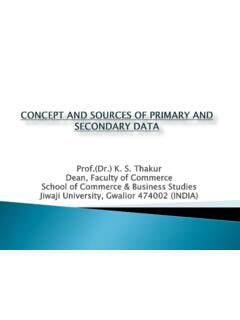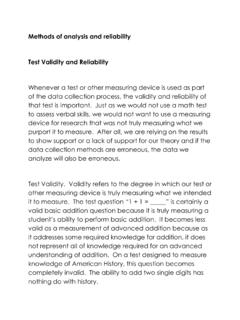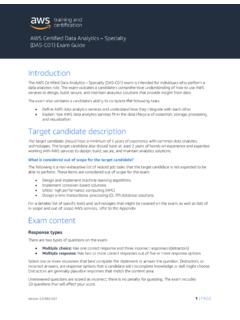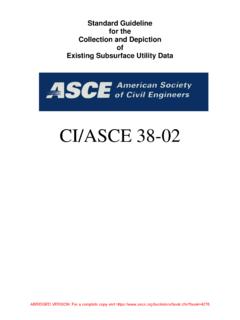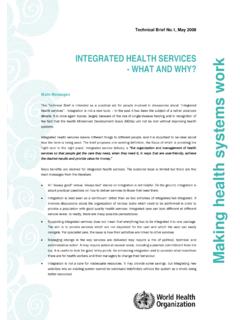Transcription of Validity and reliability of measurement instruments used ...
1 Research fundamentals measurement instruments2276Am J Health-Syst Pharm Vol 65 Dec 1, 2008 ReseaRch fundamentalsValidity and reliability of measurement instruments used in researchCa r o l e l. Ki m b e r l i n a n d al m u t G. Wi n t e r s t e i nCa r o l e L. Kimberlin, , is Professor; and Al m u t Wi n t e r s t e i n, , is Associate Professor, Department of Pharmaceutical Outcomes and Policy, College of Pharmacy, University of Florida, Gainesville. Address correspondence to Dr. Kimberlin at the Department of Pharmaceutical Outcomes and Policy, College of Pharmacy, University of Florida, Box 100496, Gainesville, FL 32610 authors have declared no potential conflicts of 2008, American Society of Health-System Pharma-cists, Inc.
2 All rights reserved. 1079-2082/08/1201-2276$ Issues related to the Validity and reliability of measurement instruments used in research are Key indicators of the quality of a measuring instrument are the reliability and Validity of the measures. The process of developing and validating an instrument is in large part focused on reducing error in the measurement process. reliability esti-mates evaluate the stability of measures, internal consistenc y of measurement instruments , and interrater reliability of instrument scores. Validity is the extent to which the interpretations of the results of a test are warranted, which depends on the particular use the test is intended to serve.
3 The responsiveness of the measure to change is of interest in many of the applications in health care where improve-ment in outcomes as a result of treatment is a primary goal of research. Several issues may affect the accuracy of data collected, such as those related to self-report and sec-ondary data sources. Self-report of patients or subjects is required for many of the measurements conducted in health care, but self-reports of behavior are particularly subject to problems with social desirability biases. data that were originally gathered for a different purpose are often used to an-swer a research question, which can affect the applicability to the study at hand.
4 Conclusion. In health care and social sci-ence research, many of the variables of interest and outcomes that are important are abstract concepts known as theoretical constructs. Using tests or instruments that are valid and reliable to measure such con-structs is a crucial component of research quality. Index terms: Control, quality; data collec-tion; Errors; Methodology; ResearchAm J Health-Syst Pharm. 2008; 65:2276-84 measurement is the assigning of numbers to observations in order to quantify phenom-ena. In health care, many of these phenomena, such as quality of life, patient adherence, morbidity, and drug efficacy, are abstract concepts known as theoretical constructs.
5 measurement involves the opera-tionalization of these constructs in defined variables and the develop-ment and application of instruments or tests to quantify these variables. For example, drug efficacy may be operationalized as the prevention or delay in onset of cardiovascular disease, and the related measurement instrument may ascertain data on the occurrence of cardiac events from patient medical records. This article focuses primarily on psychometric issues in the measurement of patient-reported outcomes. However, similar aspects of measurement quality apply to clinical and economic out-comes.
6 Steps to improve the mea-sures used in pharmacy research are also outlined. Evaluating the quality of measuresKey indicators of the quality of a measuring instrument are the reli-ability and Validity of the measures. In addition, the responsiveness of the measure to change is of interest in many health care applications where improvement in outcomes as a result of treatment is a primary goal of research. data sources for measures used in pharmacy and medical care research often involve patient ques-tionnaires or interviews. Measures using patient self-report include quality of life, satisfaction with care, adherence to therapeutic regimens, symptom experience, adverse drug effects, and response to therapy ( , pain control, sleep disturbance).
7 In addition, measures can be developed research fundamentals measurement instruments2277Am J Health-Syst Pharm Vol 65 Dec 1, 2008 The Research Fundamentals section com-prises a series of articles on important topics in pharmacy research. These include valid research design, appropriate data collection and analysis, application of research findings in practice, and publication of research re-sults. Articles in this series have been solicited and reviewed by guest editors Lee Vermeulen, , and Almut Winterstein, from patient information available in medical records, including ordered tests or medical examinations, and administrative claims.
8 Some of the measures from these data sources are considered more objective ( , laboratory tests) because the reliabil-ity and Validity of the measures are known, with the error margins and reporting of results meeting gener-ally rigorous standards. However, most data sources involve a greater degree of subjectivity in judgment or other potential sources of error in measurement . In such cases, it is in-cumbent on the researcher to control for known sources of error and to report the reliability and Validity of measurements used. reliability . According to classical test theory, any score obtained by a measuring instrument (the observed score) is composed of both the true score, which is unknown, and er-ror in the measurement The true score is essentially the score that a person would have received if the measurement were perfectly accurate.
9 The process of developing and validating an instrument is in large part focused on reducing error in the measurement process. There are different means of estimating the reliability of any measure. Ac-cording to Crocker and Algina,1 the test developer has a responsibility to identify the sources of measurement error that would be most detrimental to useful score interpretation and design a reliability study that permits such errors to occur so that their ef-fects can be assessed. Pretesting or pilot testing an instrument allows for the identification of such sources.
10 Refinement of the instrument then focuses on minimizing measurement estimates are used to evaluate (1) the stability of measures administered at different times to the same individuals or using the same standard (test retest reliabil-ity) or (2) the equivalence of sets of items from the same test (internal consistency) or of different observ-ers scoring a behavior or event us-ing the same instrument (interrater reliability ). reliability coefficients range from to , with higher coefficients indicating higher levels of reliability . Stability. Stability of measure-ment, or test retest reliability , is determined by administering a test at two different points in time to the same individuals and determin-ing the correlation or strength of association of the two sets of scores.
